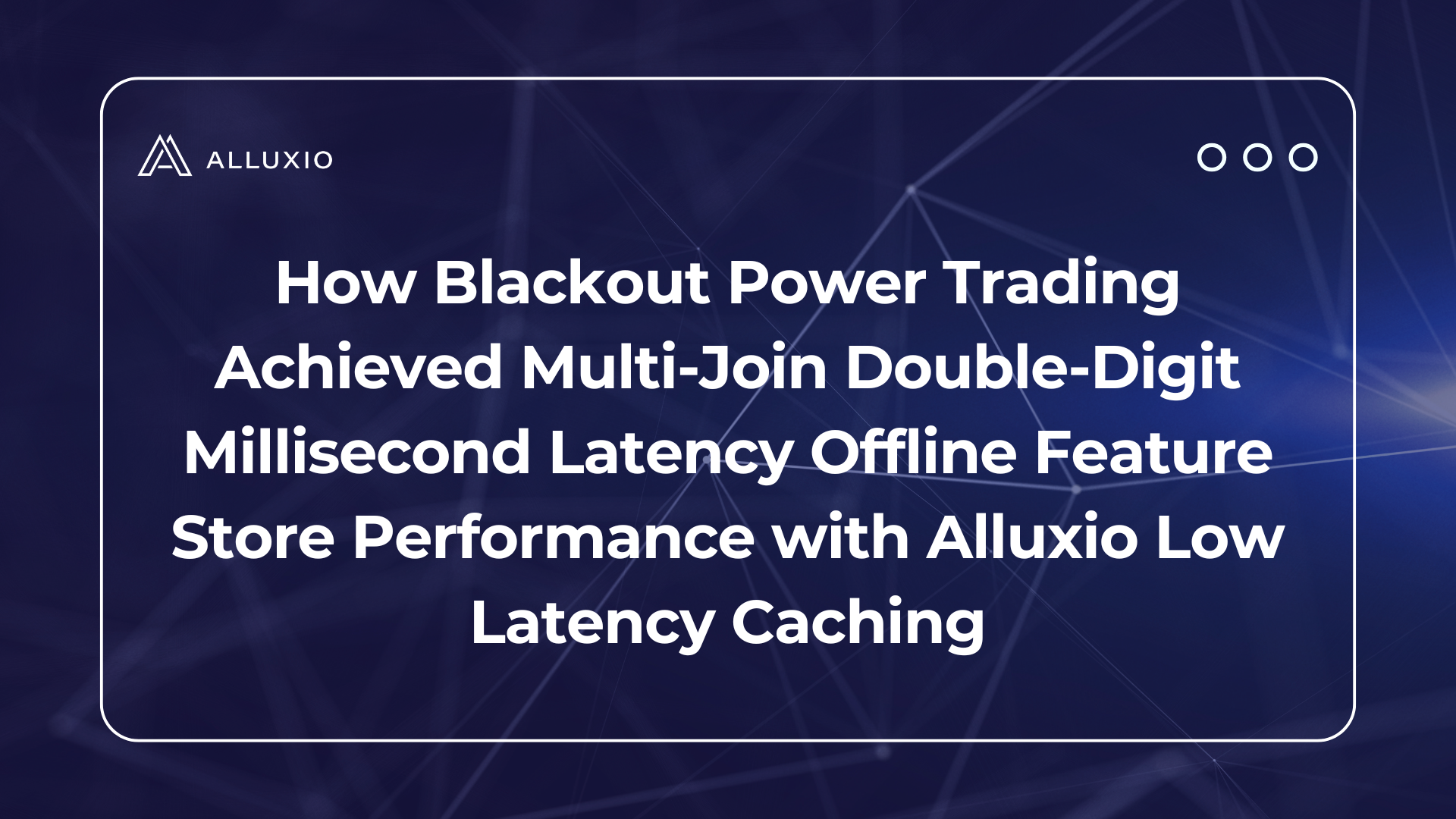Products
Blog

Alluxio's Strong Q2: Sub-Millisecond AI Latency, 50%+ Customer Growth, and Industry-Leading MLPerf Results
Alluxio's strong Q2 featured Enterprise AI 3.7 launch with sub-millisecond latency (45× faster than S3 Standard), 50%+ customer growth including Salesforce and Geely, and MLPerf Storage v2.0 results showing 99%+ GPU utilization, positioning the company as a leader in maximizing AI infrastructure ROI.

How Blackout Power Trading Achieved Multi-Join Double-Digit Millisecond Latency Offline Feature Store Performance with Alluxio Low Latency Caching
In this blog, Greg Lindstrom, Vice President of ML Trading at Blackout Power Trading, an electricity trading firm in North American power markets, shares how they leverage Alluxio to power their offline feature store. This approach delivers multi-join query performance in the double-digit millisecond range, while maintaining the cost and durability benefits of Amazon S3 for persistent storage. As a result, they achieved a 22 to 37x reduction in large-join query latency for training and a 37 to 83x reduction in large-join query latency for inference.
.png)
Thank you! Your submission has been received!
Oops! Something went wrong while submitting the form.
.jpeg)
Accelerating Write-intensive Data Workloads on AWS S3
Alluxio is an open-source data orchestration system widely used to speed up data-intensive workloads in the cloud. Alluxio v2.0 introduced Replicated Async Write to allow users to complete writes to Alluxio file system and return quickly with high application performance, while still providing users with peace of mind that data will be persisted to the chosen under storage like S3 in the background.
No items found.

Recap AWS Summit New York
Alluxio is a proud sponsor and exhibitor at the AWS Summit in New York. If you weren't able to attend, here are the highlights
Hybrid Multi-Cloud
Large Scale Analytics Acceleration
.jpeg)
The Practice of Alluxio in Ctrip Real-Time Computing Platform
Today, real-time computation platform is becoming increasingly important in many organizations. In this article, we will describe how ctrip.com applies Alluxio to accelerate the Spark SQL real-time jobs and maintain the jobs’ consistency during the downtime of our internal data lake (HDFS). In addition, we leverage Alluxio as a caching layer to dramatically reduce the workload pressure on our HDFS NameNode.
Large Scale Analytics Acceleration
.jpeg)
2.0 is here! Embrace silos orchestrate data accelerate innovation
Here in New York, at the AWS Summit, we are super excited to announce that Alluxio 2.0 is here, our most major release since the Alluxio launch. A couple months ago, we released 2.0 Preview - which included some of the capabilities, but 2.0 now includes even more, to continue building on to our data orchestration approach for the cloud.
No items found.
.jpeg)
Orchestrating Data for the Cloud World with Alluxio 2.0
Today, I’m thrilled to announce the GA of Alluxio 2.0.0, Alluxio’s biggest release to date (see our Release Notes & Release Blog) with over 900 commits.
No items found.
.jpeg)
Turn cloud storage or HDFS into your local file system for faster AI model training with TensorFlow
This article aims to provide a different approach to help connect and make distributed files systems like HDFS or cloud storage systems look like a local file system to data processing frameworks: the Alluxio POSIX API. To explain the approach better, we used the TensorFlow + Alluxio + AWS S3 stack as an example.
Large Scale Analytics Acceleration
Model Training Acceleration

Recap: Presto Summit SF 2019
Alluxio is a proud sponsor and exhibitor at the Presto Summit in San Francisco. If you missed the conference, don’t worry we’ve got you covered!
Hybrid Multi-Cloud
Large Scale Analytics Acceleration

Hybrid Environments for Data Analytics is a Possibility
As the data ecosystem becomes massively complex and more and more disaggregated, data analysts and end users have trouble adapting and working with hybrid environments. The proliferation of compute applications along with storage mediums leads to a hybrid model that we are just not accustomed to. With this disaggregated system data engineers now come across a multitude of problems that they must overcome in order to get meaningful insights.
Hybrid Multi-Cloud
Large Scale Analytics Acceleration

Embracing Data Silos: the journey through a fragmented data world
Over the years of working in the big data and machine learning space, we frequently hear from data engineers that the biggest obstacle to extracting value from data is being able to access the data efficiently. Data silos, isolated islands of data, are often viewed by data engineers as the key culprit or public enemy №1. There have been many attempts to do away with data silos, but those attempts themselves have resulted in yet another data silo, with data lakes being one such example. Rather than attempting to eliminate data silos, we believe the right approach is to embrace them.
Data Migration
.jpeg)
Effective Data Engineering in the Cloud World
Cloud has changed the dynamics of data engineering as well as the behavior of data engineers in many ways. This is primarily because a data engineer on premise only dealt with databases and some parts of the hadoop stack. In the cloud, things are a bit different. Data engineers suddenly need to think different and broader. Instead of being purely focused on data infrastructure, you are now almost a full stack engineer (leaving out the final end application perhaps). Compute, containers, storage, data movement, performance, network — skills are increasing needed across the broader stack. Here are some design concept and data stack elements to keep in mind.
Hybrid Multi-Cloud
Your selections don't match any items.

